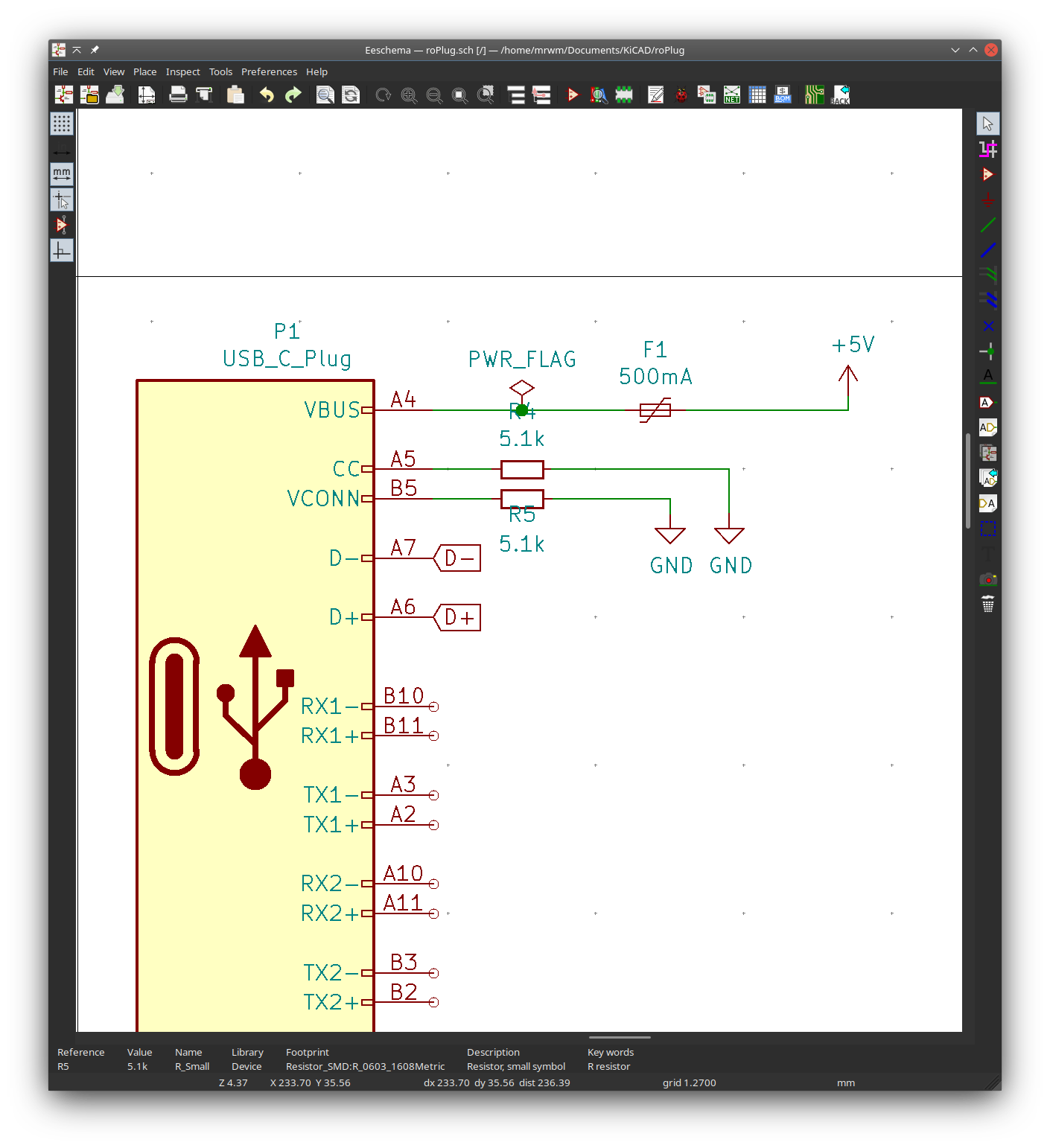why do you need the usb A adapter? does it physically fit?
i noticed on the schematic you have two 22 ohm resistors on CC and VCONN- this is wrong, you should have one 5.1k resistor on CC. might explain it
The USB-A adapter fixes and works out the bad circuitry I made on the USB-C connection, and yeah, I goofed up with the 22ohm resistors.
Correct me if I’m wrong, should both resistors be changed to 5.1k like in the first screenshot, or should CC be connected to VBUS with the 5.1k resistor in the second screenshot?

I’m trying to wrap my head around this, but I think I might be further confusing myself.
edit: This blog and this reference both say to have pull down resistors on CC and VCONN… so I guess it’s just a case of swapping the resistors?
5.1k pulldown on CC only- ya see:
the way usb C detects orientation is by detecting which pin has voltage on it. Rp and Rd form a voltage divider. you can see how if your sink is a receptacle, you need two resistors because the CC wire is actually used to detect if the cable is flipped or not.
but if there’s no cable- you can only have one resistor, for one voltage divider. if you had two the host wouldnt be able to tell the orientation.

It worked! Taking out the 22 resistor on VCONN and replacing the CC resistor with 5.1k now works without the USB-C to USB-A connector. Once I replace all the resistors on other boards, I’ll update the post, and post a demonstrational video of my expansion card in action.
Here’s the video of one of the many things roPlug can do:
The cards in the video has one as move-mouse-cursor-up/down and move-mouse-cursor-left/right. Essentially enabling an etch-a-sketch-like mouse cursor for the framework laptop.
It is also possible to change it to scroll wheel up/down, left/right, copy/paste, undo/redo… and a lot more!
Got mine, working so far, pretty sweet.
@mrwm How’s this look? It’s not as thin as you need it to be (2.2mm not including wheel), but it is thinner than what’s in use now, right?
Edit: just noticed that it’s only 3 pulses per revolution. Not too great.
It looked promising to the point where I had the EVQ-VVD00203B noted down in the github README awhile back; however, I didn’t use it due to it’s low-resolution per pulse.
It would definitely be great if it had at least 6 pulses per revolution, like the current encoders that I’m currently using. Also, the encoder doesn’t fit the footprint that the mechanical keyboard community used, which meant people can’t easily source alternative parts that are compatible to this card.
One way I think you could do a quadrature encoder in a really thin space would be kind of like this thing from polulu- sot-23 hall sensors (they detect magnets) on one side of the pcb, 90 degrees apart, and a magnet wheel on the other side. The resolution depends on the number of magnets in the wheel, as shown by this guy quite nicely.
Magnets…
I don’t think it would be a viable alternative if it will only cause problems later on, but the idea is great though!
This looks really cool. Do you plan on making any more? If so I’d be interested in getting one
I still have 3 assembled PCB’s available. I’ll temporarily open up the google form for orders.
In stock:
- 3 Assembled PCB’s
- 2 rotary encoders
- 1 PCB without parts
This means that 2 of the 3 assembled PCB’s will have the rotary encoders available.
Ill take one if they are still avaliable
I opened the form again, but I only have 1 assembled board + rotary encoder left.
Form submitted
Form closed. Not going to do another run until I save up more money for another project like this.
I still need to wrap up a couple places like cleaning up my QMK github repo for this board, and updating the configs to the new QMK requirements, but I’ll get around to do a small write-up on this project. It’s been over three years since, so I need to dig those photos and old stats. Unfortunately, I might have some that slipped through the cracks.
This has been a fun, but expensive project that I did to learn about kicad, manufacturing, setting up QMK, and all the other fun stuff.
Hopefully I’ll get around to redo the board with the recommended board layout + more breakout pins for the chip on the board, but who knows? Maybe there’ll be more people interested.
Cheers and see you guys around the forum! ![]()
The QMK configs for the roPlug can be found here:
I dont think it’s the prettiest, and I might have some of the configs wrong, but it works ![]()
Also, the write-up for the project can be found here:
https://community.frame.work/t/roplug-what-i-learned-from-making-an-expansion-card/
Alas, it appears I as a Framework 16 user have found this post too late. @mrwm might you be able to post the board’s schematics so that I could order an assembled board from JLCPCB or similar? I absolutely love this idea.
It’s been some time since I last touched it, but the files I worked on can be found in the link below:
Just note that it’s on the usbSideMount branch, not master branch.


